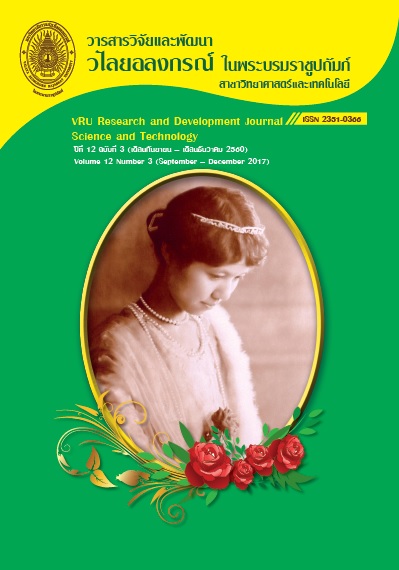การพัฒนาและฟื้นฟูดินทรายในเขตเงาฝนด้วยถ่านชีวภาพ
Main Article Content
Abstract
การผลิตถ่านชีวภาพด้วยวิธีการแยกสลายด้วยความร้อนแบบช้าที่อุณหภูมิ 500 องศาเซลเซียส โดยใช้ร่วมกับปุ๋ยหมักและสารสกัดชีวภาพสำหรับปรับปรุงดินทรายเขตเงาฝนในพื้นที่ศูนย์ศึกษาการพัฒนาห้วยทรายอันเนื่องมาจากพระราชดำริ ตำบลสามพระยา อำเภอชะอำ จังหวัดเพชรบุรี เพื่อศึกษาเปรียบเทียบคุณสมบัติทางกายภาพและเคมีบางประการของถ่านชีวภาพ พบว่า ถ่านชีวภาพจากกะลามะพร้าวมีพื้นที่จำเพาะมากที่สุด 7.83 ตารางเมตรต่อกรัม รองลงมาคือเปลือกทุเรียน 4.25 ตารางเมตรต่อกรัม ในขณะที่ถ่านชีวภาพจากเปลือกทุเรียและฝักสำโรง มีขนาดเส้นผ่านศูนย์กลางรูพรุนมากที่สุดคือ 208.80 และ 200.30 อังสตรอม เมื่อพิจารณาคุณสมบัติทางเคมีด้าน องค์ประกอบของคาร์บอน ไฮโดรเจนและไนโตรเจน พบว่า ถ่านชีวภาพจากฝักหางนกยูงให้คาร์บอน และไฮโดรเจน ในอัตราสูงที่สุดร้อยละ 72.04 และ 4.10 ตามลำดับ และถ่านชีวภาพจากเปลือกทุเรียนมีไนโตรเจนสูงที่สุดที่ร้อยละ 1.18 จากการทดลองปลูกหอมแดงพันธุ์ลับแล พบว่า ชุดควบคุม ดินรวม ดินผสมปุ๋ยหมักร่วมกับถ่านชีวภาพจากกะลามะพร้าวและ ดินผสมปุ๋ยหมักร่วมกับถ่านชีวภาพจากเปลือกทุเรียน มีการเจริญเติบโตของต้นเฉลี่ยและน้ำหนักรวมทึ่ไม่มีความแตกต่างทางสถิติ ส่วนชุดทดลองที่มีดินผสมปุ๋ยหมักร่วมกับถ่านชีวภาพจากฝักสำโรงและฝักหางนกยูง ที่มีการเจริญเติบโตและให้น้ำหนักรวมที่แตกต่างอย่างมีนัยสำคัญที่ระดับความเชื่อมั่น <0.05
Production of biochar by Slow Pyrolysis dissipation at a temperature of 500oC, combined with compost and bio-extract, to improve sandy soil in Rain Shadow in the Huai Sai Royal Development Study Center, Sam Phraya, Cha Am, Phetchaburi. When comparing some physical and chemical properties of biochar of the 4 materials tests. It was found that coconut shell biochar has the highest surface area of 7.83 m2/g, followed by Durian bark 4.25 m2/g. While biochar from Durian peel and Bastard poom sheath the highest porosity was 208.80Å, 200.30Å, respectively, When considering chemical property elements of carbon, hydrogen and nitrogen it was found that biochar from Peacock’s crest sheath gave carbon and hydrogen at the highest rate of 72.04 and 4.10 percent, respectively, and biochar from durian peel had the highest nitrogen content of 1.18 percent. From the experiment of planting shallots, it was found that. The soil control system included soil mixed with summaries biochars 4 type, biochar from coconut shell and biochar from durian peel. There was no statistical difference in growth and weight. The experiment was composted with biochar from Samrong pod and guppy pods the growth and total weight were significantly different at the confidence level <0.05.
Downloads
Article Details
Copyright Notice
The copyright of research articles published in the VRU Research and Development Journal Science and Technology Journal belongs to the Research and Development Institute, Valaya Alongkorn Rajabhat University under the Royal Patronage. Reproduction of the content, in whole or in part, is prohibited without prior written permission from the university.
Responsibility
The content published in the VRU Research and Development Journal Science and Technology Journal is the sole responsibility of the author(s). The journal does not assume responsibility for errors arising from the printing process.
References
International Biochar Initiative. (2016). Standardized Product definitio and product testing guidelines for biochar that is used in soil
JRC, IES. (2010). ILCD Handbook. International Reference Life Cycle Data System Home page. Available at: lct. jrc. ec. europa. eu/assessment/assessment/projects.
Kookana, RS, Sarmah, AK, Van Zwieten, Lukas, Krull, Evelyn, & Singh, Balwant. (2011). 3 Biochar Application to Soil: Agronomic and Environmental Benefits and Unintended Consequences. Advances in agronomy, 112(112), 103-143.
Lehmann, Johannes. (2007). A handful of carbon. Nature, 447(7141), 143-144.
Novak, Jeff, Sigua, Gilbert, Watts, Don, Cantrell, Keri, Shumaker, Paul, Szogi, Ariel, . . . Spokas, Kurt. (2016). Biochars impact on water infiltration and water quality through a compacted subsoil layer. Chemosphere, 142, 160-167.
Oochit, Dooshyantsingh, Selvarajoo, Anurita, & Arumugasamy, Senthil Kumar. (2017). Pyrolysis of Biomass Waste Biomass Management–A Holistic Approach (pp. 215-229): Springer.
Pinitpon, Pituya, Thavivongse, Sriburi, & Saowanee, Wijitkosum. (2017). Optimization of Biochar Preparation from Acacia Wood for Soil Amendment. Engineering Journal, 21 Number 2(March), 6. doi: 10.4186/ej.2017.21.2
Pituya Pinitpon. (2015). Effect of biochar application in sandy soil rain shadow area on sesame (Sesamun indicum L.) production. thesis, 166.
Saijit Daosukho; Arun Kongkeaw; Urawan Oengeaw. (2012). The Development of Durian Shell Biochar as a Nutrition Enrichment Medium for Agricultural Purpose : Part 1 Chemical and Physical Characterization. Department of Science Service, 1(1), 9.
Singh, Balwant, Dolk, Michaela Mei, Shen, Qinhua, & Camps-Arbestain, Marta. (2017). 3 Biochar pH, electrical conductivity and liming potential. Biochar: A Guide to Analytical Methods, 23.
Tenenbaum, David J. (2009). Biochar: Carbon mitigation from the ground up. Environmental health perspectives, 117(2), A70.
Warnock, Daniel D, Lehmann, Johannes, Kuyper, Thomas W, & Rillig, Matthias C. (2007). Mycorrhizal responses to biochar in soil–concepts and mechanisms. Plant and Soil, 300(1-2), 9-20.
กรมส่งเสริมการเกษตร. (2559). ฐานข้อมูลและทะเบียนเกษตรกร. รายงาน, 31.
ทวีวงศ์ ศรีบุรี. (2554). การทดสอบคุณลักษณะของถ่านชีวภาพจากเศษไม้ก่อนนำไปปรับปรุงคุณภาพดิน. บทความ.
ธัชธาวินท์ สะรุโณ. (2558). การผลิตพืชตามหลักปรัชญาเศรษฐกิจพอเพียง
ธีรพจน์ พุทธิกีฏกวีวงศ์, เจษฎานันท์ เวียงนนท์, & ภัทราวดี ศรีบุญสม. (2006). การผลิตถ่านอัดแท่งจากต้นถั่วเหลือง. Naresuan University Journal, 14(3), 8.
ศูนย์ศึกษาการพัฒนาห้วยทรายอันเนื่องมาจากพระราชดำริ. (2559). การใช้ถ่านชีวภาพในดินทรายเพื่อเพิ่มผลผลิตหอมแดง เอกสารองค์ความรู้, 16.


